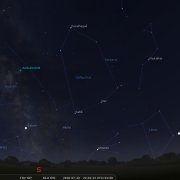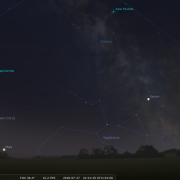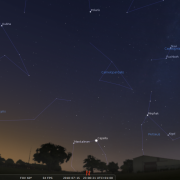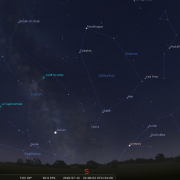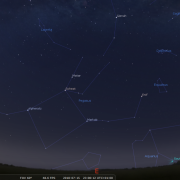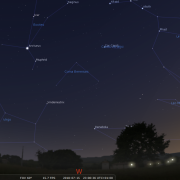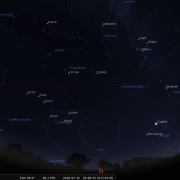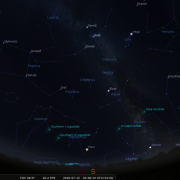In this month's Sky Notes:
Planetary Skylights
July is going to be a busy month, with all the naked eye planets visible and a total lunar eclipse to enjoy as well, weather providing!

 Let us start with the planets visible low in the west. Mercury will still be on show for the first couple of weeks, retreating back toward the WNW horizon by mid month. Admittedly it will be a little tricky to spot, but look for it approximately 40 minutes after sunset (around 22:10h) lower right of Venus. A flat, unobstructed view is a must as it will be low down. Use binoculars to help pick out this elusive world, before trying with just the naked eye. On July 14th a crescent Moon resides lower left of Mercury, but this will be a challenge with skies still bright.
Let us start with the planets visible low in the west. Mercury will still be on show for the first couple of weeks, retreating back toward the WNW horizon by mid month. Admittedly it will be a little tricky to spot, but look for it approximately 40 minutes after sunset (around 22:10h) lower right of Venus. A flat, unobstructed view is a must as it will be low down. Use binoculars to help pick out this elusive world, before trying with just the naked eye. On July 14th a crescent Moon resides lower left of Mercury, but this will be a challenge with skies still bright.
 Brilliant Venus cannot be missed, dominating the western sky. The ‘evening star’ will start to arc down toward the horizon over the course of the month. Telescopically (or through any optical aid) Venus is rather dazzling, but if you observe it as early as possible in bright twilight, you should be able to detect its phase, which is currently around half. On the 9th Venus passes just above Regulus in Leo. A crescent moon lies nearby on the 15th.
Brilliant Venus cannot be missed, dominating the western sky. The ‘evening star’ will start to arc down toward the horizon over the course of the month. Telescopically (or through any optical aid) Venus is rather dazzling, but if you observe it as early as possible in bright twilight, you should be able to detect its phase, which is currently around half. On the 9th Venus passes just above Regulus in Leo. A crescent moon lies nearby on the 15th.
 The beacon of Jupiter reigns supreme to the SSW and is a rewarding target for any sized scope. Of course the larger the aperture, the more atmospheric detail becomes apparent, including the great red spot which is facing us on the following dates; 1st, 3rd, 5th, 8 th, 13 th,15 th, 17 th, 20 th, 22 th, 25 th, 27th and 29th; timings are for around 22:30h. The Galilean moons also provide great spectacle, throwing up a different configuration each evening. Usually 2, 3 or 4 are visible strung out in line with Jupiter. Notable satellite events to look out for during the late evening (22:30h) are a shadow transit of Io on the 10th and probably more noticeable a Ganymede shadow transit on the 31st. Our moon resides to the upper right of Jupiter on the 20th.
The beacon of Jupiter reigns supreme to the SSW and is a rewarding target for any sized scope. Of course the larger the aperture, the more atmospheric detail becomes apparent, including the great red spot which is facing us on the following dates; 1st, 3rd, 5th, 8 th, 13 th,15 th, 17 th, 20 th, 22 th, 25 th, 27th and 29th; timings are for around 22:30h. The Galilean moons also provide great spectacle, throwing up a different configuration each evening. Usually 2, 3 or 4 are visible strung out in line with Jupiter. Notable satellite events to look out for during the late evening (22:30h) are a shadow transit of Io on the 10th and probably more noticeable a Ganymede shadow transit on the 31st. Our moon resides to the upper right of Jupiter on the 20th.
 Next up we have Saturn, which starts to make inroads into the evening sky. Look for a conspicuous pearly ‘star’ low to the southeast as twilight deepens. Having not long reached opposition Saturn will lie due south around midnight. Ring orientation is currently very favourable and any modest telescope should reveal them, but do be patient, waiting for those steady ‘seeing’ interludes in the often turbulent air in which Saturn resides. The tiny speck close by Saturn will be its chief moon Titan, which orbits round in 16 days. The moon lies nearby on the 24th
Next up we have Saturn, which starts to make inroads into the evening sky. Look for a conspicuous pearly ‘star’ low to the southeast as twilight deepens. Having not long reached opposition Saturn will lie due south around midnight. Ring orientation is currently very favourable and any modest telescope should reveal them, but do be patient, waiting for those steady ‘seeing’ interludes in the often turbulent air in which Saturn resides. The tiny speck close by Saturn will be its chief moon Titan, which orbits round in 16 days. The moon lies nearby on the 24th
Mars at Opposition
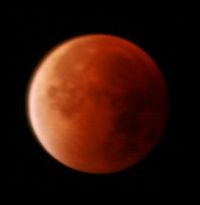 The Red planet is back in the spotlight, reaching opposition on July 27th (the same evening as the lunar eclipse). This will be the biggest and brightest appearance of Mars in 15 years with this opposition being perihelic, ie; one where Mars is closest to the Sun in its orbit. Unless you specifically wait up, Mars may seem a little shy to show its ‘ruddy’ face at first, not becoming a feature in the sky until late in the month. August will actually be more favourable.
The Red planet is back in the spotlight, reaching opposition on July 27th (the same evening as the lunar eclipse). This will be the biggest and brightest appearance of Mars in 15 years with this opposition being perihelic, ie; one where Mars is closest to the Sun in its orbit. Unless you specifically wait up, Mars may seem a little shy to show its ‘ruddy’ face at first, not becoming a feature in the sky until late in the month. August will actually be more favourable.
As with all close oppositions of Mars, media attention will be good bad and indifferent, so pay no attention to the latter two, which usually involve erroneous claims of how Mars will appear as big as a full moon, dominating the sky. The same happened for the 2003 and 2005 oppositions. Mars will not be huge but it certainly will be conspicuous, rivalling Jupiter, if not exceeding it in brilliance around opposition. On July 27th there will be a large orange red presence low in the sky that evening... the rising full moon in eclipse, the orange hue of Mars will be located below the moon down in the south east and appear ‘substantially smaller’.

In fact when viewed through a telescope Mars will still appear rather small, even at the relatively close distance of almost 35.78million miles it will only be 24.3 arc seconds across. At 4,200 miles (6,800km) across, Mars is a little over half the diameter of our planet, appearing roughly half the size of Jupiter’s disk in the eyepiece and Jupiter lies 3 times further away! Our fascination stems from the knowledge that when we observe Mars, we are scrutinising the actual surface, viewing features on a world which once had seas, perhaps primitive life forms and the largest volcanoes in the solar system ; currently dormant.
Because this opposition (opposite the Sun in the sky) occurs in July, the declination of Mars will be quite low from our latitude, only 12 degrees or so above the south horizon at local midnight. Turbulent air will therefore interfere with observations, so patience at the eyepiece will be required. On Mars itself it will be early spring in the Southern Hemisphere and the beginning of the season in which large dust storms can develop. If one does, surface detail will become difficult to discern or be completely obscured, sometimes for several weeks, another reason why post opposition viewing is often more rewarding. Mars closest approach is actually on the last day of July, 4 days after opposition, when it will be slightly brighter at mag -2.8.
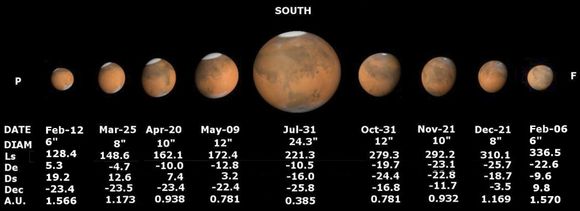
Apart from any meteorological phenomena on display, the most obvious features will be the polar caps, in particular the changing size of the southern one will be of interest, but there should be good views of the N. polar hood as well. The famous fin shape of Syrtis Major will be turned toward us on the 6-8th. On opposition night Mare Acidalium will be visible on Mars northern hemisphere, whilst to the south Mare Erythraeum and Solis Lacus will be evident. The two hour window centred on culmination will be the optimum time to observe. This means midnight to 02:00h from the UK I’m afraid.
Mars will be a dominant object well into late summer, allowing plenty of time to observe it – just don’t expect it to be as big a pizza.
Total Lunar Eclipse
The second total lunar eclipse of the year occurs on July 27th. The first lunar eclipse of 2018 occurred in January but was not visible from our shores. This eclipse is visible over most of Europe and Asia, Australia and South America. However, from the UK the start of the lunar eclipse will be hidden as the Moon will still be below the horizon, rising in the Earth’s umbra (the darkest part of the Earth’s shadow) and will already look red or blood orange.

A Rising Lunar Eclipse. (Image Credit: Gain Lee, Huddersfield Astronomical Society)
From Whitby this will be around 21:05h, clearing the horizon by 21:20h, just a few minutes before greatest eclipse occurs at 21:22h. At this point the Moon is closest to the centre of the Earth’s shadow. The umbral part of the eclipse ends at 22:13h, when the Moon leaves the deepest shadow and enters into partial phase, the orange/red colour will start to disappear, leaving a plain, dark shadow effect. This lasts until 23:19h, when the moon enters into Earth’s penumbral shadow, a much more subtle shade, lasting until 00:28h when the eclipse ends.
During totality the Moon does not disappear completely, but usually turns a deep, dark red or blood orange hue. This is because it is illuminated by light passing through the Earth's atmosphere and bending back towards the Moon by refraction. The colour of the moon at a total lunar eclipse is often influenced by earth’s atmospheric conditions, usually when there are higher than normal levels of dust or pollutants. Dust in the atmosphere blocks out the higher frequency blue light waves, but the longer wavelength of red light comes through. With several quite large volcanic eruptions occurring recently, it will be interesting to what effect this may have on the colour.
Meteors

A number of lesser meteor showers occur during July. The Capri-Cornids have 3 maxima, July 8, 15, and 26, but all have Zenith hourly rates (ZHR) of only half a dozen, the same as sporadic rates. Moon light will interfere with the last maxima.
The Alpha-Cygnids peak on July 21st, but again rates are barely more than sporadic levels. Cygnus is well placed high in the SSE by midnight. Moon light will interfere until after midnight.
The Delta-Aquarids are a little more prolific, peaking on July 30th with a ZHR of 15-18. Post midnight viewing is advised and there is little moonlight to bother about.
Noctilucent Cloud
Keep watch still for sightings of Noctilucent cloud as there has been some quite decent displays visible during the latter half of June. Mark observed this type of cloud (see last month for full feature) on several nights around midnight low to the north. Shining with a characteristic sliver blue hue, Noctilucent cloud is often on show from our latitude during June, July and sometimes early August.
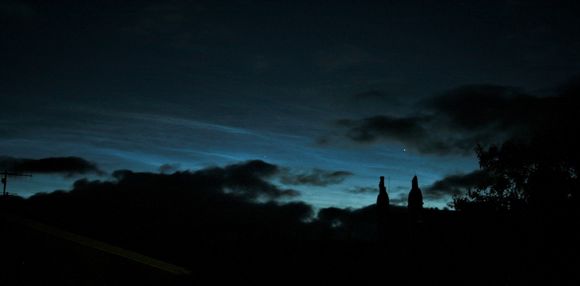
Noctilucent Cloud taken in Whitby by Mark, on 25th June 2018 at 23:52h.
|
Looking North
Mid-July - 23:00h |
Looking South |
|
Looking East
Mid-July - 23:00h |
Looking West
Mid-July - 23:00h |
|
Northern Aspect
Mid-July - 02:00h |
Southern Aspect
Mid-July - 02:00h |
Additional Image Credits:
- Planets and Comets where not otherwise mentioned: NASA
- Sky Charts: Stellarium Software
- Log in to post comments

